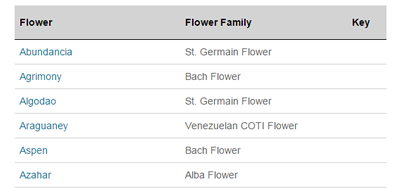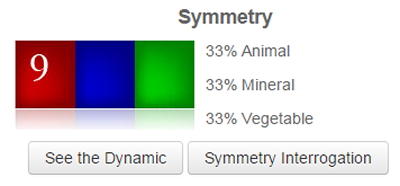What is the system for?
With simple and quick test, the flower therapist, obtains a small list that includes the mathematically most representative flowers for the patient having used more than 1500 flowers included in the system
What information do I need?

With just few information you can get a complete study to help you select the correct Flower Escence
Flower Families included in the System
What will the Study Results show me?
Selected Flowers

The "Flower" column indicates the "Harmonic Flowers" (those of greater harmony and mathematical consistency).
The "Flower's Family" column indicates the type of flower or flower compound to which said flower belongs.
The "Key" column indicates those favourite flowers that were selected by the algorithm of the harmonic group.
Impregnancy

Results Update

In the Algorithmic Study, all patient's data may be altered except for the date and place of birth. This option will allow the therapist to perform more than one study per patient, if there were doubts about some entered data. By choosing the "Result Update " option, the new test will be carried out.
How do I use the Results?
-
According to the Big Bang theory, living beings bring accumulated information of everything that was created from the beginning. Even today, new theories of modern quantum, supergravity, string theory, the M-theory, agree on the fact that we are, somehow, “transformed light” and testimony of what precedes us.
-
Equally, mathematics and numbers are the basis of all observable reality, from Pythagoras to all modern scientists.
-
All time scientists have conceived the idea of transposing and relating mathematically all observable reality to establish the basis of the "link" that gathers and connects all parts between them and the whole.
-
This is the driving idea of scientific understanding that has led men to the increasing discovery of Science.}
-
Eugene Wigner, the famous Nobel Prize winner, wrote in his article "The unreasonable effectiveness of mathematics":
- We then introduce a new criteria that reveals the information included in individuality patterns.
- A new approach towards a mathematical paradigm that suggests a phonetic-numeric code as the new criteria.
- Similarity is achieved through a key in this phonetic-numeric code that relates the phonetic-numeric qualities of flowers with those of the patient, by respecting the nature of individuality and totality.
- A statistical methodology of distribution was used for its adjustment, in order to reach a calculation as accurate as possible.
- Crosslinking of the information contained in the studied variables - for instance, Gauss' curve of symmetric distribution and Gumbel and Pearson's curves of skewed distributions - downplayed the fact that not all medicines have the same amount of symptoms, with values being constant for patient’s data.
- Given that the names of the flowers represent the Latin names of different substances, Latin was used as a sublayer of information, since the International Phonetic Alphabet (AFI in Spanish, API in French and IPA in English) has been intentionally based on the letters of the Latin alphabet. (*)
- Concordance was found in the numerical series that arises from the phonetic-numeric code in the Latin name of different flowers, with numerical series of specific patient data, turned to Latin and its subsequent phonetic-numeric code, (*)
- Thus, objective data of the patient as their full name, date of birth, name used by the person to identify itself, etc., constitutes the new identity pattern that, "transported" to the phonetic-numeric code, defines a new way of concordance.
- These objective patient's data express the representative numerical series (individual code) that is identified with numerical series of some amongst hundreds of flowers which have been used for experimentation, through mathematical algorithms.
- The result of mathematical calculation is represented hierarchically and is presented as follows:
- In this way, and with all these data, we shall be able to find the flowers among the group that demonstrate greater coherence with the matter at hand.
- The study of the algorithm as a new model of understanding does not replace the analysis and classic study of the different therapeutic approaches, but it is a powerful assistant in patient's treatment.
Are your ready to give the system a try?
If you are ready to start testing the system just register for free and contact us at info@flowerscode.com sending your username and country of residence. We will add free credits to your account and get back at you.
You can send us any questions on how to use the system, to info@flowerscode.com, and we will be able to assist you.



